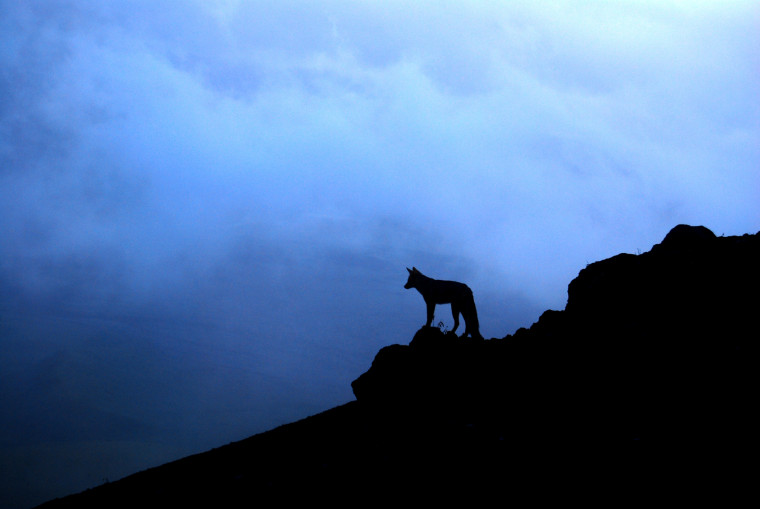Rights of Nature on the Line in Ecuador
Disregarding local opposition and risks to wild animals, a Canadian firm persists in its mission to extract gold from a sensitive ecosystem in Ecuador.
Open gallery

High in the Andes, at an altitude between 3,000 and 5,000 meters, lies one of the most unique ecosystems on Earth: the páramo. A singular combination of natural characteristics—tropical latitude, intense rainfall, extreme UV exposure, strong winds, and an altitude above the treeline but below the snowline—unite to create an environment found in very few places. In fact, the vast majority of flowering plant species in the Andean páramo are endemic to this ecosystem stretching, in limited montane niches, from Venezuela to Ecuador. These plants and the broader páramo ecosystem support an impressive range of wild animals, from the emblematic Andean condor and spectacled bear to lesser-known species like the western mountain coati, the long-tailed weasel, the Andean fox, the black-breasted puffleg, the rufous-fronted parakeet, painted frogs, and more. The páramo is also the historical, and in many cases actual, homeland of indigenous peoples. Some peoples, such as the Muisca in Colombia, revere the páramo as the originator of all life. And even for nearby urban residents, this characterization rings true: the páramo acts as a high-altitude sponge, storing water for inter-Andean cities like Cuenca, Ecuador.
Yet, like so many sensitive ecosystems around the world, the páramo’s singularity and fragility hardly guarantee protection—particularly when parts of the páramo are known to harbor significant quantities of commercially valuable minerals. Take, for example, the case of the Loma Larga project. The brainchild of Canadian mining companies I Am Gold and INV Metals, since acquired by fellow Canadian firm Dundee Precious Metals (Dundee), the Loma Larga project seeks to extract gold, copper, and silver at a site near Cajas National Park and the Quimsacocha National Recreation Area, a páramo situated some 30 kilometers from the city of Cuenca.
This blog by Nicholas Fromherz and Eve Goldman (2L) provides a brief introduction to the story of the Loma Larga project and the litigation challenging Dundee’s efforts to mine for gold in the delicate páramo. Special thanks go to Defend Them All, a locally active NGO founded by Lewis & Clark Animal Law LLM alum Lindsey Zehel (’15), for updating us on this saga and ongoing efforts to fight back.
Although the facts and history of the case are in many ways unique, they find parallels in a range of extractive projects threatening wild animals and habitat around the globe. The Global Law Alliance for Animals and the Environment (GLA) is increasingly monitoring extractive projects like Loma Larga in an effort to support progressive legal frameworks and responses capable of pushing back on a paradigm that continues to harm wild animals and their homes, all while prejudicing local human communities.
Community Opposition to the Loma Larga Project and the Current Status of Litigation
Since at least 2005, local communities have said “no” to this project. They have done so through referenda, citizen parliaments, local government resolutions, open letters, signature-collection campaigns, marches, protests, and, more recently, court filings.
In July 2022, the plaintiffs, consisting of community organizations and local NGOs, obtained an important—but only partial—victory against Dundee in court. After analyzing a range of constitutional claims, Judge Carlos Cárdenas ordered Dundee to suspend all mining activities pending the completion of a proper consultation with local residents [República del Ecuador Unidad Judicial de Trabajo Cuenca, No. Proceso01371-2022-00067 (“Loma Larga”), Sentencia 20 de julio de 2022 (on file with GLA and available through search here)].
On the one hand, this was an important win for the community. On the other hand, the court rejected the plaintiffs’ arguments sounding in violation of the rights of nature, failure to apply the precautionary principle, failure to consult specifically with indigenous peoples, and more.
Now on appeal, the lower court’s decision will face further scrutiny as the stakes grow higher. At GLA, we are watching this case carefully. To be sure, the court issued a lengthy, considered opinion that made several valid points, including vindication of consultation rights based upon the foreseeable environmental impacts of large-scale mining in the páramo. But the court’s rulings on other issues—only one of which we examine below—raise serious concerns. We hope the appellate court will correct these errors in due course.
Rights of Nature
Although the court came to a handful of troubling conclusions, its holding on the rights of nature stands out. The court’s response to this claim was dismissive and almost superficial, particularly when read in light of Ecuador’s constitutional language and recent jurisprudence. At the very least, the claim deserves a much harder look on appeal.
On behalf of the páramo and the life it supports, the plaintiffs claimed violations of the rights of nature, in accordance with Articles 71, 72, 73, and 406 of the Constitution of Ecuador. Article 71 states that nature has a right to exist and to maintain its lifecycles, structures, functions, and evolutionary processes. Procedurally, the same Article further provides that “every person, community, people or nationality may demand of the public authority the satisfaction of the rights of nature.” Articles 72 and 73 supplement this language, providing respectively that nature has a right to restoration in the event of a violation and that the State shall apply precautionary or restrictive measures “to activities that may lead to the extinction of species, the destruction of ecosystems, or the permanent alteration of natural cycles.” Article 401, for its part, emphasizes the special status of páramos in Ecuador, designating them a “fragile and threatened ecosystem” meriting careful conservation and management.
Against this constitutional backdrop, one might reasonably speculate that a large-scale mining operation within the páramo would be dead on arrival—or at the very least face an uphill battle requiring extensive scrutiny prior to approval. Simply put, it is hard to square Dundee’s vision, in this particular site, with the Constitution’s rights-of-nature provisions. This impression is only reinforced upon review of Ecuador’s case-law, including the Constitutional Court’s 2021 ruling in Los Cedros and its 2022 ruling in the Estrellita case.
As discussed in a previous blog, in 2021 Ecuador’s Constitutional Court scuttled plans to mine another extremely biodiverse area: Los Cedros biological reserve. Like the páramo near Cuenca, Los Cedros biological reserve plays host to a rich collection of wild animals and plants and furnishes critical ecosystem services, including water-cycle services, to the surrounding region. Previously, in 2017, the Ministry of Mining granted metallic mining concessions to a state-owned company in two-thirds of Los Cedros. Later that year, the Ministry of Environment approved exploratory mining and the associated use of water. Local citizens and NGOs challenged the latter decision in court, eventually convincing a provincial tribunal to vacate the Ministry of Environment’s go-ahead. On appeal, the Constitutional Court in Los Cedros upheld the lower court’s ruling, holding that the government’s conduct ran afoul of the rights of nature, the precautionary principle, the right to water, the right to a healthy environment, and procedures concerning prior consultation with local communities.
A few months later, the Constitutional Court weighed in again, this time in a case involving a captive monkey named “Estrellita.” In the Estrellita case, the Constitutional Court held that the rights of nature doctrine extends to wild animals—that, in addition to any other available legal protections, wild animals enjoy special constitutional protections as “nature.”
Focusing only on the rights-of-nature component (for now), it is difficult if not impossible to reconcile the Constitutional Court’s precedent with the lower court’s disposition in Loma Larga. If the rights of nature held by Los Cedros biological reserve and the life it supports stand as an insurmountable obstacle to metallic mining in the area, the same result would be expected for what appears to be an even larger metallic mining project in the páramo. Again, recall that páramo ecosystems are one of the few ecosystems specifically enumerated as per se “fragile and threatened” in the Constitution. Moreover, if wild animals find shelter under the Constitution’s right-of-nature provisions, as Estrellita held, what of the rights of the highly endemic amphibians, reptiles, birds, and mammals feeding, nesting, and resting in the páramo near the project site? Alas, the lower court in Loma Larga failed to offer a convincing explanation that reconciles its decision with both the Constitution’s language and the recent jurisprudence on the matter.
For more than a decade, local communities have expressed their opposition to Dundee’s plan to tear open the páramo. And while the wild animals that call the páramo home may not be able to share their opinions in human form, Ecuador’s Constitution furnishes those animals – and their habitat – ecocentric protections under the rights of nature. GLA, together with Defend Them All, urges the judiciary to build upon the precedent of cases like Los Cedros and declare Dundee’s mining vision incompatible with Ecuador’s progressive legal rubric.
***
This blog was written by Nicholas Fromherz, Adjunct Professor and GLA’s Latin American Program Director and International Animal and Environmental Law Clinic student, Eve Goldman (a Lewis & Clark 2L). The Global Law Alliance for Animals and the Environment (GLA) was launched in the fall of 2020 as an innovative collaboration of the Center for Animal Law Studies and the ranked Environmental Law Program at Lewis & Clark Law School. GLA champions wild animals and wild spaces around the world.
The Center for Animal Law Studies (CALS) was founded in 2008 with a mission to educate the next generation of animal law advocates and advance animal protection through the law. With vision and bold risk-taking, CALS has since developed into a world-renowned animal law epicenter. CALS’ Alumni-in-Action from over 20 countries are making a difference for animals around the world. CALS is a nonprofit organization funded through donations and grants.
More Center for Animal Law Studies Stories
Center for Animal Law Studies is located in Wood Hall on the Law Campus.
MSC: 51
email cals@lclark.edu
voice 503-768-6960
Center for Animal Law Studies
Lewis & Clark Law School
10101 S. Terwilliger Boulevard MSC 51
Portland OR 97219


